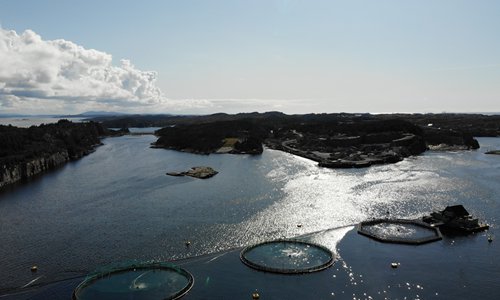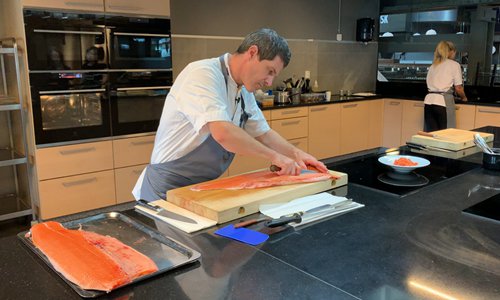SOURCE / INDUSTRIES
Surge in Norwegian seafood exports to China

Aerial photo taken on September 8 shows a Salmon farm in Bergen, Norway. Photo: Deng Zijun/GT
For most perhaps, the best time to devour seafood is when it has just been caught. But it’s not the case for Norwegian salmon.
Jostein Medhus, a Norwegian chef with 24 years of experience in seafood, recently revealed that the flesh of a fresh caught salmon is too tight for chefs to process and for diners to chew. “It’s better to wait two to three days when the flesh loosens. By that time, it’s quite easy to remove the bones without crumbling the flesh.”
Guess what? It takes exactly three days for a salmon caught from a fishing farm in Norway to be served at the table of Chinese consumers. “So, technically it’s the Chinese who get to eat the most delicious salmon instead of us Norwegians,” Chef Medhus laughed while chopping the salmon fillets.
Scientific Farming
Contrary to what the Chinese think, Norwegians prefer farmed salmon to wild ones. Because the scientific farming process allows salmon to have maximum nutrition and the minimum harmful substances like dioxins and heavy metal.
Jorgen Viksund, a staff in Øygarden Salmon Center near Bergen, explicated that a typical farm usually has six to 10 cages, each of which is consist of a buoyancy element on the surface and a net-bag below to hold the fish. The net-bag is between 20 to 50 meters deep with a diameter of 50 meters, and each of these is allowed to hold 200,000 salmons at most.
“The required ratio of water to fish is 97.5 to 2.5 in each cage. It’s stipulated by the law that the facilities of fish farms must ensure the welfare of the fish throughout its life cycle,” Viksund told the Global Times. “So they can’t live in a crowded place.”
Viksund pointed to a screen with six real-time pictures, “We have several cameras underwater functioning 7/24 to monitor how the fishes are doing. It’s a must that we make inspections all the time with the levels of hygiene in the water, fish-feedings, water temperature, and safety.”
When asked how they were going to improve the production to meet the rising need from around the world, Viksund shrugged his shoulder, “We can’t. It’s not up to us. We have to strictly follow the limit written on our farming license. That’s why you can see that the salmon volume almost maintains the same in recent years.”
Sustainable fishing
If people in Norway want to go fishing, they need both equipment and one more important thing, a mandatory license. “There are other requirements too,” Chef Medhus said. “If the fish or shell caught are too small, you have to release them back to the water.”
For professional fishermen, a fishing license is also a prerequisite. And it costs a great fortune to get it.
“Strict quotas are set for each vessel and fish species to maintain healthy fish stocks.” Knut Torgnes, sales director of Norwegian Fishermen’s Sales Organization for Pelagic Fish, introduced.
“Take mackerel, for example, the quota for total Norwegian vessels in 2019 is 152,811 tons fluctuating within 10%. That means no vessel is allowed to fish anymore once the reported catches amount to 168,092 tons.”
The organization has been mediating the sales between Norwegian fishermen and potential buyers since its inception in 1927. “All the pelagic catches are reported to our office and sold through our remote auction system. So the fishermen know exactly where to deliver the catch while they are still at sea.”
“Fishing fleet perhaps is the most regulated industry in Norway, as you can see all the resources are utilized sustainably,” Torgnes added.
Surging Chinese Market
China is a fast-growing market for Norwegian seafood. With the bilateral diplomatic ties improved, Chinese demand for seafood has also continued to rise.
Seafood exported to China from the North European nation rose 38 percent year-on-year to 3.2 billion Norwegian kroner ($357.16 million) during the first eight months of this year, data from the Norwegian Seafood Council (NSC) showed.
Norwegian seafood is popular among Chinese consumers, Victoria Braathen, director of the Norwegian Seafood Council for the Chinese mainland and Hong Kong, told the Global Times.
"Based on our annual consumer studies, 44 percent of Chinese consumers consider Norway as their preferred country of origin for salmon, which provides a very good basis for further developing the Chinese market. If the present trend continues, we can expect that the total export will be more than 20,000 tons in 2019, " she said.
"The mackerel market is also growing in China," said Roy Angelvik, State Secretary for the Minister of Fisheries, adding that 85 percent of imported mackerel were exported again to Japan after it was processed in China.
Angelvik added that China and Norway have big potential in terms of fishery science and technology, in a bid to boost the trade volume between the two countries.

Chef Jostein Medhus processing salmon Photo: Deng Zijun/GT
